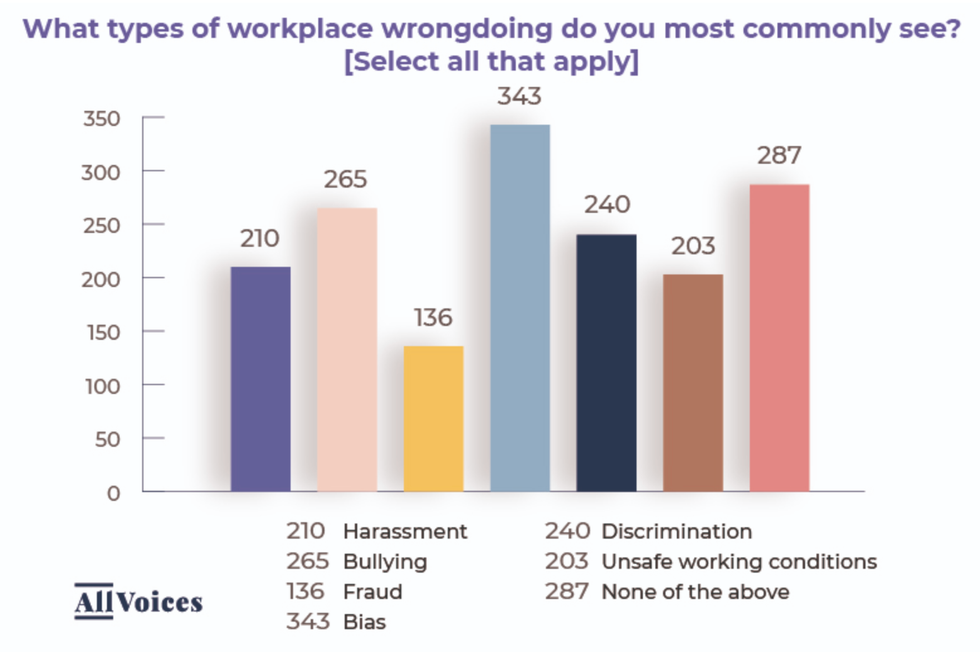It’s a particular kind of pain to work in an environment where you feel disrespected, lonely in a crowd, and unable to speak up. Unfortunately, this is a lived experience for over 61% of U.S. employees, who’ve experienced or witnessed pervasive discrimination based on race, gender, age, and sexuality.

This kind of treatment is unethical and, in most cases, illegal. Many companies have the channels and resources for reporting bias and discrimination at work, but very often, employees do not access them.
Why? Often, they’re afraid: of retaliation, hostile or toxic work environments, and a lack of anonymity. Many worry it won’t lead to anything. These reasons are understandable, and if you feel like your personal well-being or even safety will be seriously jeopardized by reporting bias, you should do what you need to do to take care of yourself. (You’ve already had to endure bias in the workplace; you don’t have to guilt yourself into “being a hero” on top of it.)
That said, the best way to dismantle the toxic power structures at play that enforce and enable bias at work is taking direct action if you’re in a position to do so – whether you’re the victim of bias or a witness of it. Choosing to report bias can create a better environment for yourself, for your underrepresented and marginalized colleagues, and for your workplace culture at large.
Whether you're personally experiencing or witnessing bias in your workplace, we’ve put together a guide that takes you through the entire process. We’ll cover:
1. What is bias?
- Definition
- Types of bias
- Examples of bias in the workplace
2. How do you report workplace bias?
- What to do if you’ve been the target of bias at work
- Handling the fear of retaliation
3. What to do if you witness bias
What is bias?
Definition
Bias is an unfair inclination or prejudice for or against a person or group, usually on the basis of identity markers like gender, race, age, ability, sexuality, nationality, body size, neurodiverse status, languages spoken, or religious beliefs. It’s the kindling for discrimination. In a workplace context, unconscious bias is all-too common — meaning, bias that’s subconsciously present in a way that the bias holder may not be aware of. These instances of bias aren’t always as glaring as blatantly racist remarks or old boys' clubs and cliques. Unconscious bias can be subtler.
Types of bias
Unconscious bias is a way that bias is held (meaning, subconsciously). It isn’t in and of itself a type of bias. Biases at work, and in society, are often centered around identity, background, and beliefs. Below, we’ve listed five of the types of biases that you’re most likely to witness at work.
- Ageism: The practice of judging and treating individuals unfairly due to their age, often overlooking them in job opportunities and promotions.
- Sexism: Unfair, biased treatment stemming from a person's gender, leading to unequal opportunities and expectations.
- Homophobia: An irrational fear or aversion toward people identifying as or perceived to be part of the LGBTQIA+ community, resulting in discrimination.
- Racism: The act of stereotyping, marginalizing, or treating individuals unequally based on their race. Racism works in one direction; it’s wielded by those with power and privileges connected to their race against those whose race does not afford them with power and privileges in that society. In other words, “reverse racism” does not exist.
- Ableism: Devaluing or discriminating against individuals based on their disabilities, often leading to unequal access to opportunities and resources.
The biases above are illegal. According to the US Equal Employment Opportunity Commission (EEOC), employers cannot treat employees unfairly based on race, color, religion, sex (including pregnancy, gender identity, and sexual orientation), national origin, age (40 or older), disability, or genetic information.
Also read: How to Deal with Racism at Work
Examples of bias in the workplace
Bias can present itself in different ways. Here are just a few examples:
- Microaggressions: A coworker insists that an employee of color be called by a nickname because their name is “too hard to pronounce.”
- The “Maternal Wall”: Once a woman becomes a parent, she hits a wall in terms of her promotions and earnings and is not able to advance due to biases and a lack of opportunities.
- Gaslighting: A boss downplays a neurodiverse employee's achievements, making them feel that their work isn't valuable or recognized, and questions their competence even if they’ve been performing well.
- Pay inequality: Women are still compensated less for their work than men, in spite of equal competence and ability.
- Exclusionary social behavior: Consistently leaving an employee or a particular group of employees out of social events, the lunch table, or informal outings.
Some biases play out in seemingly “harmless” ways and are written off as jest or denied altogether. Very often, they can cost an individual their career progression, mental health, and self-esteem, and ultimately prevent them from performing to their full potential.
How do you report workplace bias?
Reporting workplace bias is not just a matter of knowing the procedures. It’s also a matter of managing your mental health, seeking support, and understanding the legalities involved.
What to do if you’ve been the target of bias at work
1. Record everything.
Former head of the FBI James Comey used to sit in his car, lock himself in after meetings with the President, and write down absolutely everything he could remember about what happened. According to memory scientist Julia Shaw, you should do the same: as soon as it happens, and before talking to anyone else about it.
Note down details like the date, time, location, manner of bias, whether there were any witnesses, and other relevant information. If you are using photos, ensure that they are time-stamped. You should do this as often as incidents take place, to establish that there is a pattern of biased behavior and not just a one-off incident.
“Attach any proof you may have, and always back up these files and store them in multiple locations,” advises Riley Beam, managing attorney at Douglas R. Beam, P.A.
“Should you take this further and consult an attorney, this documentation will prove extremely valuable [in helping] your attorney present your case well and fight for your legal rights without worrying about loopholes in your claims.”
2. Understand your rights within the company.
As soon as you decide to report the bias, reread your employment contract, company policies, and your employee handbook; or scour the company’s intranet or HR resources to understand your rights and strategize next steps. Look out for details like:
1. Non-discrimination and Equal Opportunity policies: Almost all contracts and employee handbooks will contain explicit language about the company's stance on bias, discrimination, and harassment.
2. Reporting procedures, including the specific person or department you should reach out to, the form your report should take, and the timeline you should expect for the process.
3. Dispute resolution: Some employment contracts will detail the steps that will be taken in the event of a dispute, including mediation or arbitration procedures.
6. Record keeping: Check whether there are guidelines on how long records are kept. If there's a time limit for making a claim, you need to be aware of it.
3. Seek support.
What you’re experiencing can be an emotionally taxing process. Lean on your therapist, friends, and family – but don’t forget trusted colleagues and allies who can support your case, as well as Employee Resource Groups where you can open up about your experiences and seek advocacy support.
4. Consider having a conversation with the perpetrator.
If you feel comfortable and safe doing so and wish to avoid the administrative rigmarole of reporting your experience, you can consider speaking directly to the person in question, says Adrienne Couch, Human Resources analyst at LLC services. “[Focus] on facts and how those instances made you feel. Use ‘I’ statements to express your feelings, which can help to avoid making the other person defensive.”
It’s understandable if you’re nervous about the prospect of directly confronting the individual. “From my experience, if direct communication is not an option or does not yield positive results, you could consider seeking a neutral third party for mediation.
This could be another senior person in the organization who you trust or a professional mediator.
5. Follow the procedure.
Once you’ve determined there’s no other best option for you but to go ahead with the report, follow the steps outlined in your contract, handbook, or relevant HR resources.
What if you don't have reporting channels at work?
“If there is no policy, then approach your HR team and ask to speak to someone to ask what your next steps should be,” says Tracey Beveridge, HR Director at Personnel Checks. “Make sure you follow whatever guidance you are given so you can be sure you are doing things correctly, but do keep raising the issue until you get a result.”
Pro tip
According to Neil Platt, Director of Emerald Home Improvements, an important step would be to report the incident to several responsible authorities through multiple channels. “This is important because if you restrict your complaint to a single platform, there may be a delay in addressing your concerns or even an attempt to play down the incident. When you report it to several people at once, all those responsible for appropriate action will have to move forward diligently because they’re aware that everyone else is watching, too.”
6. Prepare for an investigation.
Your HR department will most likely conduct an investigation, where you’ll be interviewed or asked to provide a written statement. Be prepared to clearly and succinctly describe what happened, how it made you feel, and how it impacted your work. Be honest and precise.
If the situation is severe, or if you're unsure about any part of the process, you might want to consider seeking legal advice. A lawyer who specializes in employment law can help you understand your rights and navigate the process.
Handling the fear of retaliation
Retaliation is illegal in employee discrimination cases. According to the EEOC, the standard for proving a retaliation claim requires showing that the offending party's action might deter a reasonable person from opposing discrimination. This could include unfair performance evaluations, engaging in verbal or physical abuse, making reports to authorities (such as reporting immigration status or contacting the police) or threatening to do so, and more.
“The fact of the matter is, many employees do not trust HR, or at the very least have a connection with the department. This prevents trusting relationships and, therefore, trust that HR will properly support them through the process. Underrepresented professionals also tend to have less trust for organizations. The onus should not be on employees solely to navigate this, but on how companies can preemptively create a culture of connection and inclusion that eliminates bias at its root.”
– Gabby Fricke, Global DEIB Strategist and Trainer at PowerToFly
Here’s what you can do:
- Consult a lawyer before taking the matter up to internal company investigation or mediation. Their knowledge of city, state, and federal laws can help you chart out the best path forward – while protecting yourself.
- File a charge with the EEOC. If you plan to take legal action against the company, you first have to file a charge with the EEOC.
- File your report anonymously. Unfortunately, many companies do not offer the option to be anonymous. If that’s the case, you can consider using platforms like Do Not Pay, which allow you to submit claims anonymously.
What to do if you witness bias
We’ve covered what to do if you’ve personally experienced bias in your workplace. What happens if you’re not on the receiving end of bias, but you witness someone else experience it?
“When someone is a witness to bias, there are two methods they can choose to approach the situation with: ‘calling out’ and ‘calling in,’ Fricke says. She adds:
“Calling out is where a person can stop a conversation or action in the moment, and it lets the person committing the act of bias know that what they’re doing isn’t okay. Calling in typically happens post-incident as a one-on-one conversation and learning opportunity.
“In any situation, a witness should check in with the person who was on the receiving end of the bias and see what type of support they need moving forward.
“Sometimes that support can look like processing what happened together, reporting the situation, performing mediation, or sometimes doing nothing. The witness should always respect the decision of the person who experienced the bias.”
If you are a witness to bias, educate yourself on company procedures and document the incident. Write down the details of the incident, including the date, time, location, individuals involved, and exactly what happened. This can be helpful if the person who experienced the bias does choose to report the incident, or if you are called upon as a witness in an official capacity.
Unless you believe there’s an immediate threat to someone’s safety, proceed to report the incident only with the consent of the person targeted. Respect the privacy of that person, too. Don't share details of the incident without their permission.
Having the courage to report bias at work
Reporting bias at work can be extremely intimidating, but it's a crucial step toward creating an inclusive, respectful, and fair workplace for all. Armed with the right knowledge and approach, you have the power to make a big difference — not just in your own career, but in the lives of your colleagues and the overall culture of your organization, too.
Whether you're seeking job opportunities in an inclusive environment, looking for mentors, or needing advice on how to address workplace issues, PowerToFly is committed to supporting you every step of the way. We believe in your potential and want to help you foster a workplace that respects and values all its members.
Join our community to access a welcoming educational space where you can apply to open roles, network with hiring managers, connect with diverse professionals, upskill, and more — all from the comfort of your own home (or wherever you are!).



